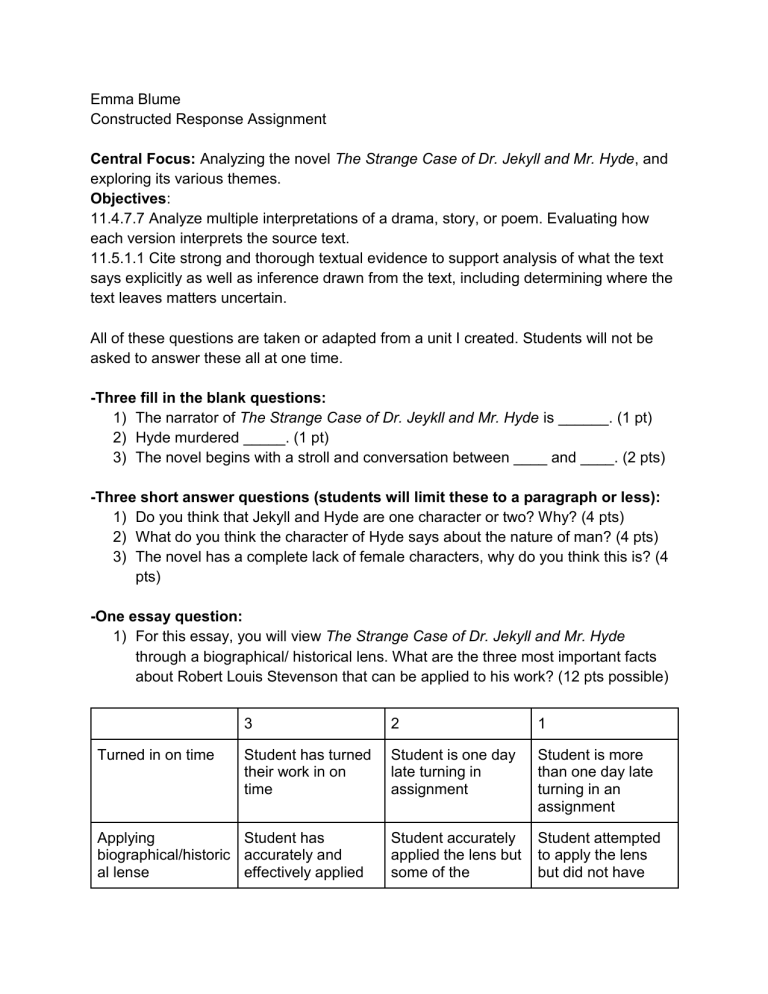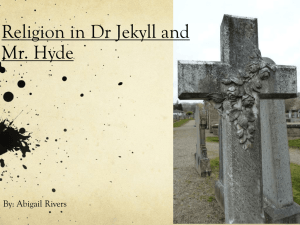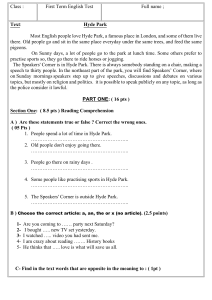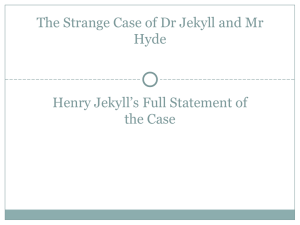
Emma Blume
Constructed Response Assignment
Central Focus: Analyzing the novel The Strange Case of Dr. Jekyll and Mr. Hyde , and exploring its various themes.
Objectives :
11.4.7.7 Analyze multiple interpretations of a drama, story, or poem. Evaluating how each version interprets the source text.
11.5.1.1 Cite strong and thorough textual evidence to support analysis of what the text says explicitly as well as inference drawn from the text, including determining where the text leaves matters uncertain.
All of these questions are taken or adapted from a unit I created. Students will not be asked to answer these all at one time.
-Three fill in the blank questions:
1) The narrator of The Strange Case of Dr. Jeykll and Mr. Hyde is ______. (1 pt)
2) Hyde murdered _____. (1 pt)
3) The novel begins with a stroll and conversation between ____ and ____. (2 pts)
-Three short answer questions (students will limit these to a paragraph or less):
1) Do you think that Jekyll and Hyde are one character or two? Why? (4 pts)
2) What do you think the character of Hyde says about the nature of man? (4 pts)
3) The novel has a complete lack of female characters, why do you think this is? (4 pts)
-One essay question:
1) For this essay, you will view The Strange Case of Dr. Jekyll and Mr. Hyde through a biographical/ historical lens. What are the three most important facts about Robert Louis Stevenson that can be applied to his work? (12 pts possible)
3 2 1
Turned in on time Student has turned their work in on time
Applying biographical/historic al lense
Student has accurately and effectively applied
Student is one day late turning in assignment
Student is more than one day late turning in an assignment
Student accurately applied the lens but some of the
Student attempted to apply the lens but did not have
the lens to
Stevenson’s work with supporting evidence using three examples evidence was not supported well, only two examples were given enough evidence to support it, only one example was given
Grammar and spelling
Little to no grammar and spelling mistakes were made
4-5 grammar or spelling mistakes were made
6 or more spelling and grammar mistakes were made
1. Complete Reflection Questions:
- What are some strengths of this type of assessment?
This type of assessment allows students to be creative and show a higher level of understanding.
- What are some weaknesses of this type of assessment?
Because it is subjective, teachers have to be very exact about their rubrics as to not cause confusion about grades received.
- When should this type of assessment be used?
This type of assessment should be used when the teacher needs to check for deeper understanding.
-When should this type of assessment NOT be used?
This type of assessment should not be used when the student has a reading disability or does not speak English yet.
-What data can be gained from this type of assessment?
Data can be collected on which students have a deep understanding of the material. These kind of questions are impossible to make up answers for if you do not understand the material.
-How can the data gained from this type of assessment be used in the learning process?
Teachers can take what students show that they know and fill in the gaps in knowledge with the things that they still need review on.
Peer Review:
Krissa reminded me that I had to assign points to each questions, so I did that. She also suggested that I edit my first short answer question because the question sounded more like an essay, so I fixed that too. Very helpful and constructive. I suggested changes of a few gramma tical elements of her assessment plan, but overall it was very solid and didn’t need a lot of work.


